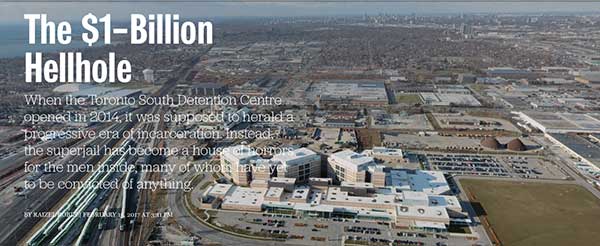On January 27, last, 22-year-old Jalani Hibbert was charged with one count of second-degree murder after the death of 41 year old Victor Ogundipe inside Toronto South Detention Centre. The weakening and dehumanizing conditions in this $1.3 billion facility, which we as taxpayers will be paying off for the next 30 years, is a travesty.

Ogundipe’s death behind the walls of this institution is one of many. In the first two years after the facility was opened, four inmates were killed and 14 committed suicide. There were 249 inmate-on-inmate assaults and 118 assaults on staff. The violence, suicide, murder, overcrowding, overworked correctional officers, and government austerity continue to cause major concerns.
When the Toronto South Detention Centre opened on January 27, 2014, the 73,000 square foot building was lauded as an innovative rehabilitative space. Years later the facility has become an ineffective representation of an overcrowded prison industrial system – one which was developed by the architectural firm Zeidler, who incidentally, also built the Eaton Centre Galleria.
It was the first jail in Ontario to use pre-fabricated modular cells. Built in Atlanta, Georgia and shipped by rail car, these cells break the spirit of men and cultivate social isolation and may well lead mental illness. Recently, freedom of information inquiries have disclosed that more than 100 employees in the facility missed consecutive shifts in 2016. A new employee starts with a salary of $26.96 an hour, including overtime the hourly rate can reach as high as $34.09. The Sunshine list, which is a directory of public employees earning more than $100,000 per year, listed many well-paid correctional workers. In 2016, a general duty officer earned $176,585. Furthermore, in the 2015-2016 fiscal year 1.1 million hours of overtime was logged within Ontario corrections.
So the question is: Why should we care? There are many answers, but for the average person in Ontario the answer is simple. Almost all prison sentences end. These young and older men will be released back into our neighbourhoods.
The all too common illustration and mythos of incarceration in Canada is a farce. We collectively feel that our justice system is reasonable and nowhere near some of the mortifying conditions within the U.S prison industrial complex.
Let us look at what a “lockdown” really is within the Toronto South Detention Centre. During lockdown, showers and phone calls are limited and in some instances restricted, and inmates must remain in their cells. There is no access to fresh air, no TV, and no exercise. Some inmates have spent up to 6o per cent of their year in the Toronto South Detention Centre on lockdown (243 days). Some inmates have experienced up to 17 days straight without leaving their cell; no shower, no phone calls, no family, no exercise – housed within a hot cell, with no reasonable air flow with a cell mate.
Inmate Jeffrey Bedward spent 225 days in lockdown during a 520-day stay from July 2014 – November 2015. In 2016, a Superior Court judge reduced three months from his sentence due to his “lived experience.” The law firm Koskie Minsky is now preparing a $1-billion class action lawsuit against the provincial government on behalf of inmates who have experienced the lockdowns.
So why should taxpayers care? Quite frankly, we must begin to ask our government some hard questions. Are efficient and cost saving prison models working, if we have less staff? Or more overtime? Is there room for social procurement and community benefit agreements in the justice system? Or will we continue to outsource development and labour? Does our government have a rehabilitative strategy for the thousands of inmates returning home? Most importantly can our government balance public safety and human rights issues?
The malady that plagues our justice system is driven by ignorance and apathy, an attitude of “I don’t know and I don’t care.”
The call to action is simple. We must learn to care. On August 10, it will be “Prisoners Justice Day”, which is set aside to remember all the men and women who have died unnatural deaths inside Canadian prisons.
As we approach this day, let us remember that members of our communities convicted of crimes are sent to prison as punishment for their crimes – not to receive pain and punishment.
Victor Beausoleil
Caribbean Camera
July 5, 2017
The biggest malady of the justice system, in my opinion, is NOT "I don't know and I don't care..." but rather a deeper, bigger problem.
The "justice system" ALLOWS this to continue saying that it's legal --AND-- what makes this worse is that there are those that would oppose better conditions, etc.
If the "justice system" allows this behavior by default, what does that say about the entirety of the legal system in place itself? This to me is the biggest problem.
The balance of power must be restored.
Downvoting a post can decrease pending rewards and make it less visible. Common reasons:
Submit
Hi! I am a robot. I just upvoted you! I found similar content that readers might be interested in:
http://www.thecaribbeancamera.com/news/editorial/care-behind-prison-walls/
Downvoting a post can decrease pending rewards and make it less visible. Common reasons:
Submit